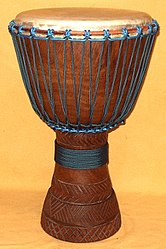 Lenke wood djembe from Mali | |
| Percussion instrument | |
|---|---|
| Classification | Membranophone |
| Hornbostel–Sachs classification | 211.261.1 (Directly struck membranophones, goblet drums, one membrane, open at one end) |
| Developed | c. 1200 AD |
| Playing range | |
| 65–1000 Hz. | |
| Related instruments | |
| Dunun, Bougarabou, Ashiko, Goblet drum | |
| Musicians | |
|
Bolokada Conde, Soungalo Coulibaly, Mamady Keïta, Famoudou Konaté, Drissa Kone Douguitigui Kone, Dramane Kone Sayba Kone | |
| More articles or information | |
| Dunun, Mandinka people | |
A djembe or jembe (/ˈdʒɛmbeɪ/ JEM-bay; from Malinke jembe [dʲẽbe],[1] N'Ko: ߖߋ߲߰ߓߋ[2]) is a rope-tuned skin-covered goblet drum played with bare hands, originally from West Africa. According to the Bambara people in Mali, the name of the djembe comes from the saying "Anke djé, anke bé" which translates to "everyone gather together in peace" and defines the drum's purpose. In the Bambara language, "djé" is the verb for "gather" and "bé" translates as "peace."[3]
The djembe has a body (or shell) carved of hardwood and a drumhead made of untreated (not limed) rawhide, most commonly made from goatskin. Excluding rings, djembes have an exterior diameter of 30–38 cm (12–15 in) and a height of 58–63 cm (23–25 in). The majority have a diameter in the 13 to 14 inch range. The weight of a djembe ranges from 5 kg to 13 kg (11–29 lb) and depends on size and shell material. A medium-size djembe carved from one of the traditional woods (including skin, rings, and rope) weighs around 9 kg (20 lb).
The djembe can produce a wide variety of sounds, making it an extremely versatile drum. The drum is very loud, allowing it to be heard clearly as a solo instrument over a large percussion ensemble. The Malinké people say that a skilled drummer is one who "can make the djembe talk", meaning that the player can tell an emotional story (the Malinké never used the djembe as a signaling drum).
Traditionally, the djembe is played only by men, as are the dunun that always accompany the djembe. Conversely, other percussion instruments that are commonly played as part of an ensemble, such as the shekere (a hollowed-out gourd covered with a net of beads), karignan (a tubular bell), and kese kese (a woven basket rattle), are usually played by women. Even today, it is rare to see women play djembe or dunun in West Africa, and African women express astonishment when they do see a female djembe player.[4]
- ^ Friedländer, Marianne (1992). Lehrbuch des Malinke (in German) (1st ed.). Leipzig: Langenscheidt. pp. 279, 159–160. ISBN 978-3-324-00334-6.
- ^ Faya Ismael Tolno (September 2011). "Les Recherches linguistiques de l'école N'ko" (PDF). Dalou Kende (in French). No. 19. Kanjamadi. p. 7. Retrieved December 17, 2020.
- ^ Doumbia, Abdoul; Wirzbicki, Matthew (2005). Anke Djé Anke Bé, Volume 1. 3idesign. p. 86. ISBN 978-0-9774844-0-9.
- ^ Cite error: The named reference
Flaigwas invoked but never defined (see the help page).